1. “From First Race Ever to Local Elite”
The Runner:
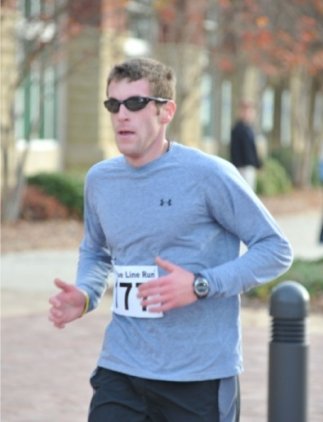 Richard Harris
Richard Harris
Age: 25
Location: Charlotte, NC
Previous PR’s
5k – 19:10
Half Marathon – 1:24:30
[slider title=”Expand to read more about how we helped Richard -“]
The Problems:
- Richard had a very limited training background and had never trained in a somewhat structured running environment.
- Richard was piecing together workouts and information gathered from Runners World, books, and other sources with no long term planning concerning the development of his training.
- With limited racing experience, Richard didn’t know how to race effectively and maximize his fitness on race day
- Richard lacked the confidence and had a hard time motivating himself to do the harder workouts necessary to improve his race times.
What We Did:
- First, with the help of Richard, we created a long-term plan to start targeting the goals Richard wanted to hit over the next few months and for the following year. We went back and analyzed the long term plan every few months to make sure we were still on target. For the most part, we were always ahead of target and adjusted his goals based on his increasing level of fitness.
- With a long term plan in hand, we detailed Richard’s training schedule using three week blocks. This detailed plan assigned each run with a specific purpose, which was explained to Richard so he could see and understand the direction of his training.
- Richard and his coach worked extensively on practicing and developing the racing skills necessary to race to his best each time out. To do this, his coach assigned him specific workouts, such as cut down runs and hammers, each week that were designed to practice these skills.
- Our awesome community and the friends Richard made on the site help hold him accountable for his workouts and kept him motivated and confident that he was moving in the right direction.
The Results:
- After less than a year working together, Richard’s new PR’s are:
5k – 16:56 (a 2 minute and 14 second improvement) *Updated 8/5/10 – Richard PR’d at 16:40
Half Marathon – 1:20:50 (a 3 minute and 40 second improvement)
- The process of developing his racing skills is a long and ongoing process, which took lot of practice and patience on Richard’s part. However, he has improved his pacing skills considerable, which has allowed him to run a more tactically efficient race. The results of his practice are evident in his racing times.
- With the great success he’s had over the last few months, Richard is excited to attack each workout on his schedule and now views the tough workouts as a challenge instead of something that he doesn’t think he can do. As a coach, it is a phenomenal feeling to watch an athlete develop that type of confidence.
[/slider]
.
2. “From Often Injured Master’s Runner to New Personal Bests in 6 Months”
The Runner: ………
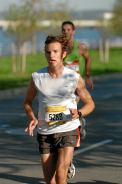 Tim Parker
Tim Parker
Age: 46
Hometown: Baltimore, MD
Previous PR’s
10 mile-58:50
Half Marathon – 1:21:40
.
[slider title=”Expand to Read More About How We Helped Tim -“]
The Problems:
- Worried that age was the cause of his lack of progression in personal best times over the last few years.
- Running too hard on his easy days, which was causing him to be fatigued going into his important workout sessions and not being able to hit his times.
- Not doing the right type of running to specifically address the demands of his target race distances of 10 mile to the half marathon. For example, too much VO2Max workouts at the expense of developing aerobic strength.
- Frequent injuries, which derailed training at inopportune times.
What We Did:
- First, we took a look at Tim’s race performances across the board, from 5k to the half marathon. This helped us identify the weak areas in his current fitness and assign workouts that appropriately addressed these weaknesses.
- Tim’s coach assigned him specific paces for all of his runs to ensure that he ran his easy days easy enough to recover for the next workout session.
- Tim kept in touch with his coach to ensure that his body was responding to the training as intended
- We worked on developing Tim’s aerobic strength so he could better handle the specific demands of the 10 mile to half marathon race distance.
The Results:
- After only three months of working together, Tim dropped is half marathon PR by more than a minute and thirty seconds to 1:20:13 at the very hill Baltimore Half Marathon. In 2010, Tim PR’d again to break 1:20 for the first time ever, posting a 1:19:40 finish at the Richmond Half marathon.
- Tim took more than 30 seconds off his course PR at the Baltimore Club Challenge in February. This was the first race of the spring and a great sign of things to come.
- Tim hasn’t missed a step of running due to injury since August of 2009, despite running some of the best workouts of his life.
[/slider]
.
3. “Working around an unorthodox schedule for a 10-minute half marathon PR”
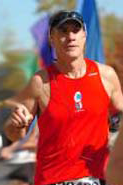 The Runner: ………
The Runner: ………
Dan Frengel
Age: 44
Hometown: Baltimore, MD
Previous PR’s
Half Marathon – 1:52
10-miler – 1:26:40
Marathon: 3:55:13
.
[slider title=”Expand to Read More About How We Helped Dan –>”]
The Problems:
- Dan has an unconventional work schedule that requires an interesting mix of hard days and easy days that aren’t often addressed in normal training programs. For example, he works all day Tuesday and into Wednesday, which negates any possible workouts on those two days. Dan was the perfect example of someone who can benefit from our custom training program, at a very affordable price.
- Dan was having success at some of the shorter distances, but could not translate that to the longer ten-mile and half marathon distances.
- Dan had difficulty pacing himself during races, which was causing him to fade during the later half of his races.
What We Did:
- First, we created a very customized schedule for Dan that not only allowed him to get in the necessary workouts that would allow him to race faster, but also maximized his recovery time during his unorthodox work schedule. Furthermore, during the first few months, we used constant feedback to ensure that his body was responding as intended.
- We worked extensively on developing a sense of pace. It is not an easy or quick process, but through the use of track workouts and specialized cutdown workouts, Dan was able to grasp the “feel” of pacing. Furthermore, we provided detailed race plans for Dan that mapped out a target pace for each mile, which helped him transfer his new sense of pace to a stronger finish on race day.
- Finally, we totally reworked the type of workouts Dan completed. First, we identified his weaknesses and spent two months working exclusively on developing physiologic areas that needed improvement. Then, we moved the training to a half marathon focus, with specifically targeted workouts.
The Results:
- After only two months working together, Dan recorded personal bests at the 10-mile and half marathon distance. His most recent half marathon race was a 10-minute improvement. Not only did he break the 1:50 barrier for the first time, but her nearly skipped the 1:40’s all together.
Half Marathon PR – 1:41:06
10-mile PR – 1:20:19
- Later in the Fall, Dan crushed his Marathon PR by almost 30 minutes, running 3:25 at the Marine Corps marathon.
[/slider]
.
4. “First time runner finishes 5k in just 2 months”
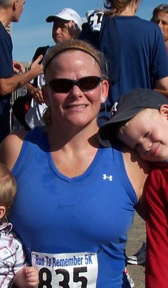 The Runner: ………
The Runner: ………
Paige Poray
Age: 37
Hometown: Washington, DC
Previous PR’s
Has never run before
Wants to finish a 5k and become healthier in general
.
[slider title=”Expand to Read More About How We Helped Paige –>”]
The Problems:
- Has never run before and has no idea where to start. The idea of finishing a race in the next 2 months is a scary and daunting task.
- Seven months post pregnancy with her second child and still carrying the extra weight she desperately wants to get rid of
- Has a hard time developing the confidence to run harder and finish longer runs that she knows she needs to do to be successful.
What We Did:
- First, Paige started on one of our beginner plans that very slowly and incrementally increased her running distances while adding in walking breaks to help her exercise longer and take away the fear associated with long, extended runs.
- We talked to Paige about taking each training week one week at a time and not looking to the future. While we certainly had a long-term plan in mind, showing Paige what she would be running 4 or 6 weeks down the road would have been daunting and reinforced negative attitudes that she couldn’t do it.
- Paige used our vast library of training articles and training clinics with detailed explanations and examples of the running workouts she was to complete. Furthermore, Paige checked in with the Live Coach Chat to ensure that her body was responding to the training as intended and participated in the forums to help her answer any questions she might have after completing a run.
- Our supportive community kept Paige motivated and moving towards her goals when minor interruptions from her family kept her from sticking with the schedule.
The Results:
- After only two months working together, Paige finished her first 5k in 40 minutes while running the entire distance.
- More importantly, Paige has been bitten by the running bug. She has signed up for a 6 mile race just 5 weeks after her first 5k and plans to complete her first half marathon this January. We couldn’t be more excited about Paige’s complete change in perspective about running and her belief in what she can accomplish.
[/slider]
.
5. “First time marathon finisher”
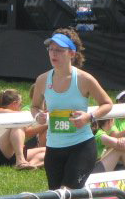 The Runner: ………
The Runner: ………
Kimberly Dewrell
Age: 32
Hometown: Baltimore, MD
Previous PR’s
Half Marathon – 2:10:41
Marathon – Long-time goal to finish
[slider title=”Expand to Read More About How I Helped Kimberly –>”]
The Problems:
- Kimberly had the long-time goal of finishing a marathon, but she did not know how to transition from the half marathon training she was currently doing and apply it to the marathon.
- Worried that her busy job as a teacher would affect her ability to get the training in, especially during the short, cold winter months.
- Because Kimberly had never trained for the marathon, she didn’t know how to properly fuel herself on long runs or in races. Furthermore, Kimberly had trouble developing her sense of pace and finding her ideal marathon pace.
What We Did:
- First, we provided Kimberly a plan that slowly progressed from her half marathon training, which consisted of roughly 20 miles per week and a 11 mile long run, to very marathon specific fitness. Each workout built incrementally on the previous week, which allowed Kimberly’s body to easily adjust to the training, but also gave her the confidence that she could run the entire distance.
- Using our vast library of nutrition articles and training clinics, Kimberly worked diligently on strategies for eating and drinking before and during the race. Kimberly experimented with different types of nutrition products and fueling strategies that allowed her to easily and confidently eat during the run.
- With constant checking-in with her friends on RunnerConnect, Kimberly stayed motivated and continually adapted her workouts through one of the snowiest winters in Baltimore’s history.
The Results:
- Kimberly finished the Frederick Marathon in record heat that reached 88 degrees. Despite the oppressive weather, which forced almost a 1/4 of the field to quit, Kimberly successfully finished her first marathon!
[/slider]
.
6. “Needed to drop 4 minutes to qualify for Boston…PR’d by 10 minutes”
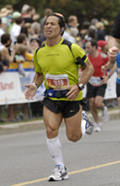 The Runner: ………
The Runner: ………
Peter Tiscione
Age: 50
Hometown: Montreal, Canada
Previous PR’s
Marathon – 3:39 (qualifying standard is 3:35)
Half Marathon – 1:44
.
[slider title=”Expand to Read More About How We Helped Peter –>”]
The Problems:
- Peter was running his recovery runs too fast, which meant that he was not recovering properly and not rested enough for his scheduled hard sessions. This made it difficult to run faster workouts.
- The workouts Peter was doing were not marathon specific. He relied too heavily on slow long runs and shorter speed sessions. Neither of these workouts specifically targeted Peter’s weaknesses or the specific marathon fitness he needed to develop.
- Peter has a busy and often hectic schedule. He not only owned his own business, which requires him to be on his feet most of the day, but he also teaches at a local University. It was important that his schedule factor these outside influences to be most effective.
- Peter lacked the confidence to attack his workouts and perform training runs that he was capable of doing. Often, he would talk himself out of a workout before it even began.
What We Did:
- First, we worked very hard to slow Peter down on his easy runs. While this is never an easy task for any runner we work with, by giving him direct paces to follow and continually expounding on the benefits of slowing down, we were able to get the most out of each run and workout he did.
- Peter’s workouts became much more marathon specific. Every mile he ran was specifically designed to elicit a certain physiological benefit. We implemented threshold intervals, long runs that increased fuel efficiency, and shorter speed elements that helped him improve his form and mechanics.
- By implementing a progressive schedule and using detailed race strategies, we were able to give Peter the confidence he needed to run the paces and times during workouts and races we knew he was capable of. Once he trusted that his assigned paces were doable, he gained the confidence to attack each race and workout.
The Results:
- After only 5 months working together, Peter qualified for the 2011 Boston Marathon. His new personal best’s are now:
Half Marathon – 1:36:46
Marathon – 3:28:40
- With the qualifying time a distant memory, Peter is excited about training for the Boston Marathon and making his race a memorable experience and another big PR.
[/slider]
.
7. “A 16 minute PR at 10k”
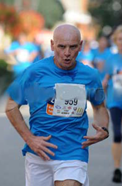 The Runner: ………
The Runner: ………
Jim Cherry
Age: 50
Hometown: Science Hill, KY
Previous PR’s
10k – 1:13:00
Half Marathon – 2:18:00
[slider title=”Expand to Read More About How I Helped Jim -“]
The Problems:
- Jim had a very unstructured training program that relied on runs that were either too easy or in the “gray” zone of training – too slow to gain benefits, but too fast to truly be a recovery run.
- Although he had been running for about 4 years, Jim was fairly new to racing. His limited race experience was causing inconsistent race results and a he had a lot of questions about proper warm-up and race strategy.
- Because Jim had never really trained before, he didn’t know how to properly run workouts or effectively pace himself during speed workouts or tempo runs.
What We Did:
- First, we identified the areas of weakness in Jim’s fitness by analyzing his past race results and current training paces.
- Because Jim had never done speed work before, and he is an older runner, we needed to introduce speed work very gradually into his training plan. First, we started with short strides after his easy runs and then slowly introduced short bursts of speed into his long runs and tempo run days. This enabled us to slowly build up his tolerance for faster and more difficult training.
- To help Jim adapt to the race demands and environment he would encounter, I assigned him very specific paces on his tempo workouts on the track. This enabled him to develop a “feel” for how hard he should be running. Eventually, we moved the workouts to the hilly terrain of his normal running routes and developed his sense of pace on the roads.
- Through consistent communication with his coach, we monitored how Jim’s body was responding and adapting to the workouts and the new workload.
The Results:
- After less than a year working together, Jim’s new PR’s are:
10k – 56:56 (A 16- minute improvement!)
Half Marathon – 2:02:11
- Not only did we see huge improvements in Jim’s race times, but he also lost almost 8 pounds. Furthermore, Jim has developed more confidence in his training and abilities and has changed his goals and outlook for 2011.
[/slider]
.

